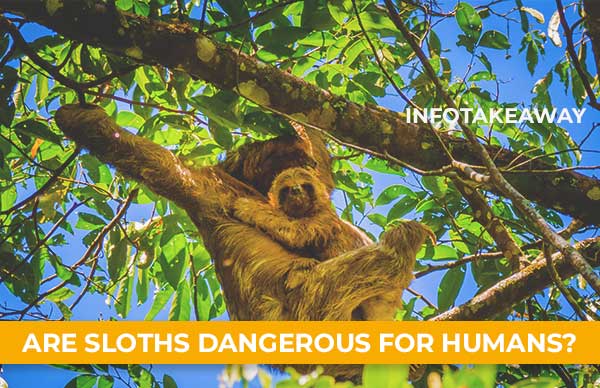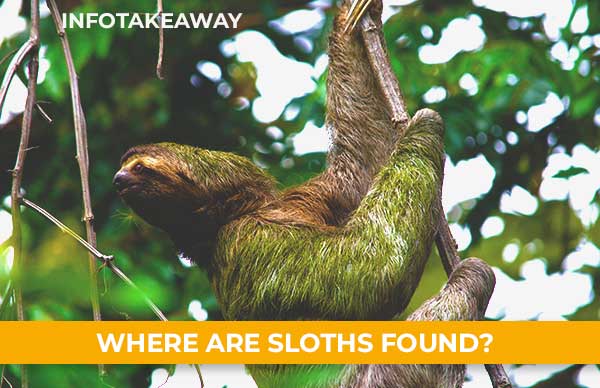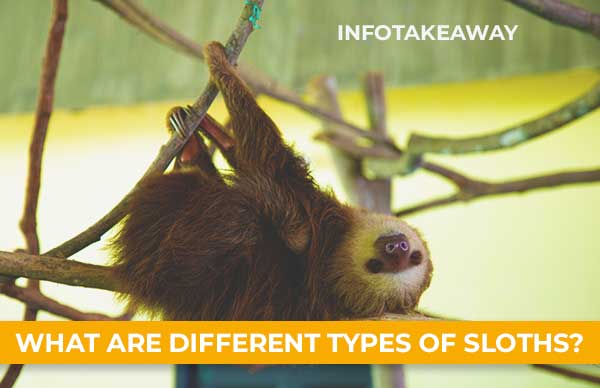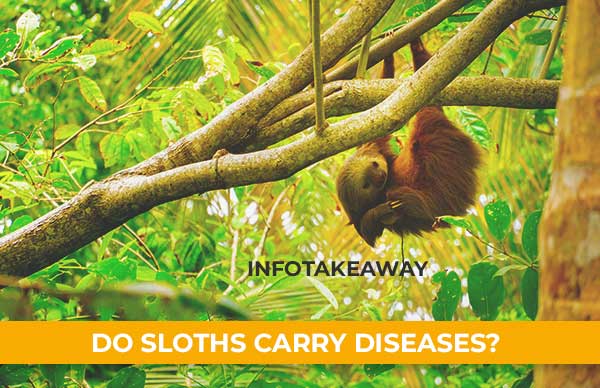Sloths are an incredible and lethargic creation of nature that tends to live on treetops. Are sloths dangerous to human beings? Are these incredibly slow animals dangerous?
Can they attack and cause harm? This may seem like a bit weird question. But a lot of people come up with this question in their minds.
If you also wonder about the answer to this question, we have got you covered. We also wondered the same and did some research to see what we could find out.

Sloths Are Dangerous If Aggravated
Sloths, although, are not dangerous to human beings, but this is the case only when they are left alone in the natural habitat they live in.
If threatened in any way, this animal can easily lash out with its long claws and can surely cause damage.
So honestly, you are not likely to come across a sloth while crossing paths, but even if you do, it is always best to keep a distance from these wild animals.
Not only this, there are some other reasons not to come close to sloths. They can bite humans and transfer harmful diseases to them by their bite.
Sloths have bodies covered with a thick layer of fur. Inside this fur, they carry creatures like mosquitoes.
These mosquitoes can pass out to humans when sloths bite them. So, this is the answer in a nutshell to the question are sloths dangerous.
Not only this, there is a lot more about sloths, their types, where they can be found, and many more facts about which we have provided all the information.
Keep reading to know more about this incredibly amazing creature.
Where Are Sloths Found?

Sloths, also known as sluggish tree-dwellers because of their slowness of movement, are from Central and South America.
So, they are found throughout the areas of Central and South America. Their habitats have been seen in some parts of Peru and Brazil as well.
For their habitat, they usually prefer tropical rainforests where they live high in trees.
They spend most of their time either hanging upside down from the tree branches or curling up themselves on these high trees.
They eat, mate, and sleep and even give birth to baby sloths upside down. Isn’t it amazing?
Can Sloths Be Kept As Pets?
Many pet enthusiasts choose baby sloths for a cuddly and family-friendly pet. Wild sloths are playful and affectionate with a very easy-going temperament.
This animal is unlikely to run away and can live up to 30 years or even more. While many people think that sloths can be kept as pets, there are a big number of cons to having one.
So, can sloths be kept as pets, or are sloths dangerous? Let’s find out the answer by going through the different pros and cons of having sloth pets. Although, manned sloths are considered to be vulnerable.
Pros:
- Many individuals and their families find sloths appealing, and they think that sloths are ‘cute’ animals.
- As sloths are slow in their movement, it is very easy to keep track of them and not run away quickly.
- Even if they can make sounds, sloths are not that much noise, making them peaceful enough to not engage in any destructive behavior.
- Another fact and the benefit of having sloths as pets is that they are generally very clean. So, once they have gotten used to living in your house, they are comfortable.
- Sloths are attractive pets.
Cons:
Does not matter how attractive a sloth looks like a pet; the disadvantages of having one are substantial enough to discourage pet keepers from purchasing a sloth. Below are some of the cons to keeping a pet sloth:
- Sloths are usually very pricey, so their purchase can be expensive.
- Sloths come in the category of toxic animals, so their purchase is often difficult from a legal point of view as well.
- If your pet sloth becomes ill, it will require a high level of specialized veterinary care which can cost you a lot. So, if you have decided to keep this pricey animal as a pet, its insurance is advisable. This insurance is not only advisable but a legal requirement in many places too.
- Even if you have afforded to keep sloth as a pet and have legalized keeping one, many places like apartments and hotels do not allow their entry as they are exotic animals.
In short, they are wild animals. Even if they appear endearing and attractive as our domestic pets, they maintain their instincts of being exotic wild animals.
What Are Different Types Of Sloths?

Five different species of sloths are known to exist. Their names are listed below.
- The pale-throated three-toed sloth.
- The Linnaeus’s two-toed sloth
- The maned sloth
- The brown-throated three-toed sloth
- The pygmy three-toed sloth
Mylodon Sloths
Mylodon is an extinct type of ground sloths that were found in discovered fossils in South American deposits of the Pleistocene Epoch.
They had a length of 10 feet (3 meters). Their skin was observed to have many bony parts, which were supposed to protect against predators’ attacks.
Mylodon fossils were found in human cave deposits, which suggests that people of those times hunted and ate sloths.
They had well-developed claws, which they might have used to dig up tubers.
A feature that distinguishes Mylodon from the rest of the ground sloths is the presence of triangular cheek teeth, upper canine teeth, and a small first toe on the hind limbs in them.
Two-Toed Sloths
Choloepus is an example of two-toed sloths. Their sloths are often mistakenly called their two fingers.
Members of this type have three digits on their hind-limbs and two digits on their forelimbs.
They are larger than three-toed sloths. The body length of wild sloth ranges from 58 to 70 centimeters and weighs around 9 to 18 lb (4 to 8 kilograms).
Two-toed sloths spend a major part of their lives hanging upside down the trees.
Primarily, they eat leaves but depend upon also berries, nuts, some small vertebrates, bark, shoots, fruits, and even some native flowers.
Three-Toed Sloths
These sloths are the world’s slowest mammals. Slowness in its movements is so much that even algae grow on its furry coat.
Babies of the three-toed sloths often cling to their mothers. The first nine months after birth, baby sloths travel by hanging on to their mothers.
With extra neck vertebrae, they can turn their heads to even 270 degrees.
Do Sloths Carry Diseases?

Sloths carry diseases to some extent. How? Let’s see.
Both physiologically and genetically, sloths are different mammals. Phleboviruses are arboviruses that parasitically cause diseases in humans and animals all over the world.
Sloths host a fascinating array of these disease-causing arboviruses. They are also known to be reservoirs of some protozoa which cause leishmaniasis disease in human beings.
Moreover, as we have already mentioned that sloths carry some disease-causing creatures in their fur, such as mosquitoes, these creatures can also pass out diseases to humans.
Some Facts About Sloths
Though most of the frequently asked questions about sloths like their types, nature, disease-carrying capacity, and pros and cons have already been explained, we have enlisted these amazing facts to give you more information about this incredibly fascinating creation of nature.
Their Strength Is Triple Times Stronger Than Us
A highly specialized muscle arrangement makes sloths three times stronger than us. Even if they have 30% less muscle mass than mammals of the same size, sloths’ strength is three times stronger than humans. Their unique locking mechanism makes it easy for them to sleep even while hanging on the trees.
Sloths Are Blind
Due to a very rare eye condition called rod monochromacy in sloths, sloths lack all the cone cells and thus, are blind. They can see only in dim light and are completely blind in bright light.
Their Speed Is Faster In Water Than Land
Although sloths spend a major part of their lives hanging on the tress, they surprisingly turn out to be excellent swimmers. They can swim in water three times faster than their walk on the ground.
They Take Up To 30 Days To Digest A Leaf
Sloths have the slowest metabolic rate as compared to all mammals. It implies that it takes a good amount of time for sloths to digest anything. Researches have shown that sloths take 30 days to digest a leaf.
They Can Fall From A Height Of 100 Feet Without Any Injury
Anatomically, sloths are designed in such a way that they can fall from a height of 100 feet too without getting injured. They are designed to survive falls. Do you know that the sloth poop comes within a week?
Conclusion – Are Sloths Dangerous
We hope we have managed to answer questions like ‘are sloths dangerous?’ in detail.
Summing up the entire discussion is that sloths can be dangerous only when threatened in any way. The sharp claws sloths are found in Central America.
So, it is advisable to maintain a distance from them as they carry some disease-causing creatures. The sloth from the Animia animal kingdom is vulnerable.
Moreover, sloths have their own set of pros and cons of being kept s a pet. As they host disease-causing arthropods, they can cause different diseases in humans. Pygmy sloth is enlisted in endangered species. So we should take care of those giant sloths.
We hope you have detailed knowledge of threats from the wild sloths. You can ask anything in the comment section regarding this blog.
Go check out our other articles, “Do Ants Have Brain?”, “Does Toner Damage Hair?” and “What Are Snake Berries?“.